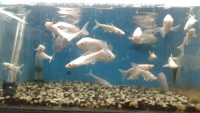Blue Grass Guppies are highly sought after for their mesmerizing blue coloration and intricate grass-like patterns. Breeding them successfully requires a deep understanding of their genetics, environment, and care. Here’s a complete guide to breeding Blue Grass Guppies while ensuring consistent and vibrant traits in their offspring.
Breeding Blue Grass Guppies requires patience, attention to detail, and proper care. By understanding their genetics, maintaining ideal breeding conditions, and prioritizing a healthy diet, you can ensure vibrant, consistent coloration and patterns in the next generation of Blue Grass Guppies.
Red Mosaic Guppies are a stunning strain known for their vibrant red hues and intricate mosaic tail patterns. Understanding their genetics can help br
Setting up an angelfish breeding farm can be a fulfilling and profitable endeavor if done correctly. To ensure the health of your angelfish and the su
RTP Guppies are a stunning addition to any aquarium, celebrated for their vivid colors and active personalities. Whether you’re a beginner or an exp
Selecting top-quality Blue Panda Guppies is essential for creating a vibrant and thriving aquarium. With their striking blue and black patterns, these
Essential Watering Tips for Healthy Growth and Blooms Proper watering is essential for the health and vitality of dahlias, ensuring lush foliage and
Red Moscow Guppies are known for their striking deep red coloration. To maintain and enhance their vibrancy, they require a well-balanced diet rich in
Blue Dragon Guppies are a remarkable addition to any aquarium, prized for their dazzling colors and lively behavior. Providing a balanced and nutrient
Effectively managing breeding cycles is crucial for success in angelfish farming. Proper breeding practices ensure a steady supply of healthy fry, opt
Introduction Green Moscow Guppies are a stunning variety known for their deep green iridescence and unique genetic traits. Understanding the genetics
Colorful shrimp, such as Neocaridina and Caridina species, are popular for their stunning appearance and active behavior. However, maintaining their h
Blue Topaz Guppies are highly sought after for their shimmering blue tones, making them a favorite among hobbyists. Breeding these fish to preserve th
Blue Dragon Guppies are a stunning addition to any aquarium, known for their vivid coloration and peaceful demeanor. But are they suitable for communi

Price: N/A

Price: N/A

Price: 35 Tk

Price: N/A

Price: N/A

Price: N/A

Price: N/A

Price: 800 Tk

Price: N/A

Price: 3000 Tk